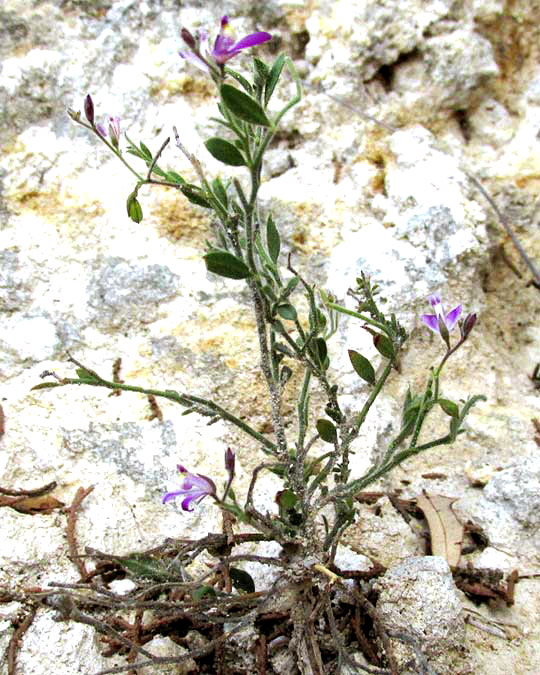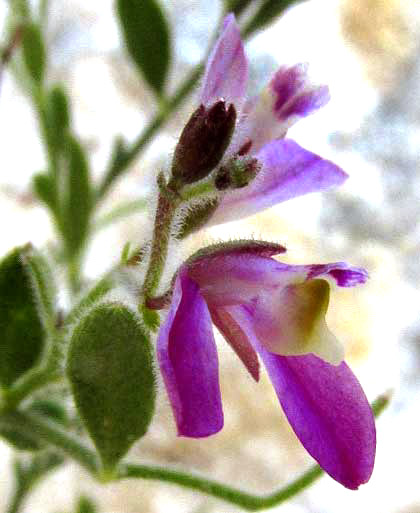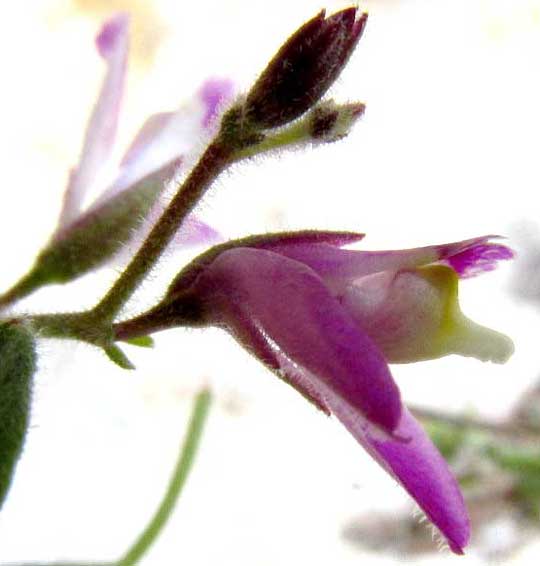Excerpts from Jim Conrad's
Naturalist Newsletter
from the August 17, 2014 Newsletter issued from the Frio Canyon Nature Education Center in the valley of the Dry Frio River in northern Uvalde County, southwestern Texas, on the southern border of the Edwards Plateau; elevation ~1750m (~5750 ft); N29.62°, W99.86°; USA
PURPLE MILKWORT
On an almost-vertical cliff face along the Dry Frio river, rooted in what seemed to be solid, marly-limestone rock, a mere sprig of a wildflower only about six inches tall
(15cm) somehow was surviving the current drought, and even blossoming. Below you can see it with its leaves about 10mm long (3/8ths inch), and purple, branch-tip flowers:

In that picture notice the dead, decaying stems from previous years slumped below the plant, informing us that this is a perennial. A close-up of a flower is shown below:

Another flower shown from the side is shown below:

At first glance, because of the flower's two-lipped (bilaterally symmetrical) corolla, the plant struck me as one of those members of the Bean Family in which the Bean Family's normally compound leaves have been reduced to a single leaflet. However, up close the flower didn't look like a typical "papilionaceous" bean blossom, plus the Bean Family's stipules -- tiny, leafy flanges at petiole bases -- weren't apparent. Also, that thick, greenish item in the flower's center didn't make sense. Apparently this wasn't a Bean Family member.
Last December we encountered a similar small perennial similarly growing on a bank of the Dry Frio, and at that time we went through the same thought process beginning with the Bean Family. Ultimately that plant revealed itself as a member of the Milkwort Family, the Polygalaceae, closely related to the Bean Family. So, back at the computer it was a simply matter to see whether another member of the Milkwort Family might occur in Uvalde County, and such was the case.
In books and on the Internet our plant often is referred to as the Shrubby or Purple Milkwort, POLYGALA LINDHEIMERI*. For the pleasure of experiencing a "variation on the milkwort theme," you might enjoy compare our present Purple Milkwort with the one found last December, the Eggleaf Milkwort, at http://www.backyardnature.net/n/h/polygala.htm.
Our Shrubby or Purple Milkwort occurs in Texas, southern New Mexico and Arizona, and adjacent northeastern Mexico. Little is known of this plant found in such a limited area, but it seems to favor limestone.
In 2009, J. Richard Abbott did his PhD dissertation at the University of Florida on the Milkwort Family, the Polygalaceae. Sequencing the genes of various species in the family, he discovered that the big genus Polygala consisted of quite a number of similar looking species that were not too closely related. He broke up the genus, so that today both the Polygalas found in Uvalde County no longer are Polygalas. The Eggleaf Milkwort found last December is now Hebecarpa ovatifolia, and our present Shrubby Milkwort is Rhinotropis lindeimeri.
However, at this time most web pages and printed field guides continue to list them both as members of the genus Polygala, and both are referred to as milkworts.